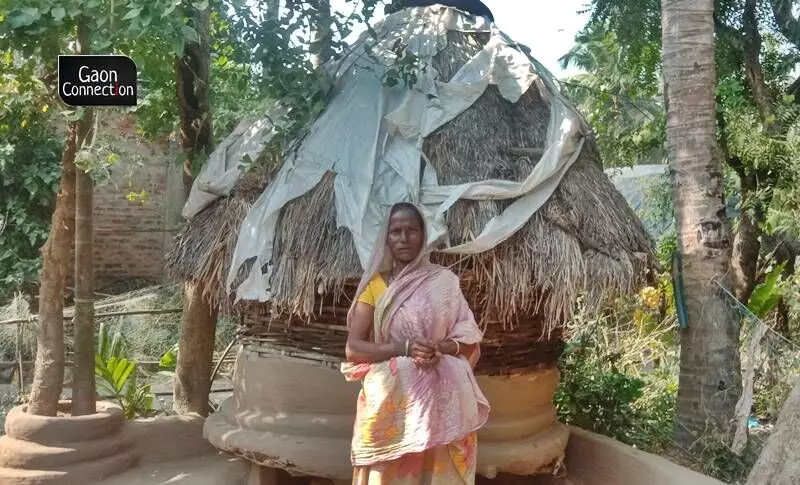The 'Gola' grain storage facility in rural Odisha
The gola is a traditional and eco-friendly storing facility, once a very common sight in rural Odisha. It is made out of bamboo, then slathered in mud and cow dung and topped with a thatched roof. Paddy and other grains are stored in them soon after harvesting. But, these silos are slowly vanishing.
 Ashis Senapati 13 Dec 2022 7:49 AM GMT
Ashis Senapati 13 Dec 2022 7:49 AM GMT

Golas play a pivotal role in preventing losses caused by pests, pathogens and rodents. Photos by Ashis Senapati
Bhagirathi Mandal refuses to believe that the traditional gola (store houses) of his village Harianka in Kendrapara district, can ever be replaced.
"It is impossible for us to preserve crop harvest without the gola. Even the most advanced type of storehouses fall short in performance. Golas were important in the past, are important now and will remain relevant in the future," the 62-year-old farmer vehemently declared, as he stood in front of a gola that looked like a thatched hut.
The gola is a traditional and eco-friendly storing facility, once a very common sight in rural Odisha. It requires considerable craftsmanship to construct one. It is made out of bamboo, then slathered in mud and cow dung and topped with a thatched roof. Paddy and other grains are stored in them soon after harvesting.
"We build it near our homes and store rice, black gram and green gram besides traditional seeds in the gola. It can hold from 25 to 50 quintals of harvest," Mandal told Gaon Connection.
Also Read: Sustainable cooling to make post-harvest management affordable for Indian farmers
Indigenous storage
Nandakishor Das, from the seaside village of Padmapur in Jagatsinghpur district was wistful when he remembered the gola from his childhood.
Sambhu Ray from Kharinashi village regularly repairs the gola where he stores paddy.
"When I was a child, almost all the 40 families of our village preserved paddy and other grains in the gola. Now barely ten families have them," 55-year-old Nandakishor Das told Gaon Connection. He feared that these hardy, time-tested and traditional means of storing crops might disappear altogether.
Madhaba Das seconded him and said that the traditional store house was slowly being edged out. "In just three decades the number of golas has declined by 50 per cent in the homes of farmers in the coastal districts of Kendrapara and Jagatsinghpur," Madhaba Das, a farmers leader and vice-president of Kendrapara Krusaka Sabha, said.
According to Nandakishor Das, "Nowadays, many poor villagers get rice from the government under the one-rupee scheme, so they do not need to preserve paddy crops in the golas. Also, many paddy farmers in seaside villages have converted their paddy fields into prawn farms, and as a result, paddy fields are shrinking."
Also Read: 'Nuakhai' — Odisha's harvest festival that celebrates the reaping of paddy
Though rice is the staple food and crop of more than 200,000 farmers in Kendrapara district, the area under rice cultivation is reducing by the day.
"The mushrooming of shrimp farms is wiping out rice crops and so the local inhabitants are no longer interested in building golas," Narayan Haldar, the former sarapanch of Kharinashi Gram Panchayat in Kendrapara district, told Gaon Connection. He added that it costs anything between Rs 5,000 and Rs 10,000 to build a gola. And once built, they last for about 10 years.
Also Read: Our godowns are full. Where are we going to keep our stock until the new ones are built?
Benefits of gola
Sambhu Ray from Kharinashi village regularly repairs the gola where he stores paddy.
Ray swears that the gola-preserved rice is tastier and that it is more nutritious. "The storehouses are plastered with cow dung to protect the food grains and seeds, and as it is a repellent, it keeps pest attack at bay," he told Gaon Connection. Ray learnt the art of making the gola from his father. "But my sons and daughters-in-law are not interested in learning the ropes at all," the 65-year-old said sadly.
Talking about the eco-friendly grain-storage system, Surya Narayan Mishra, a senior scientist of Krishi Vigyan Kendra (Odisha University of Agriculture and Technology) at Kendrapara said, "Golas play a pivotal role in preventing losses caused by pests, pathogens and rodents. We have been advising farmers to continue preserving their harvests in the golas."
"He went on to inform that at present the government has no plan to spend money to promote the building of these structures," Mishra told Gaon Connection.
"Using golas as storehouses is an old method used by farmers to store their food grains. These structures are comparatively cheap and eco-friendly. Many farmers also store paddy in jute bags mixed with dried neem leaves for longer preservation of the crops in the golas. And, the high temperatures inside help maintain grain quality by killing insects and their larvae," Mishra explained.
#Odisha #grain #Granaries #Agriculture
More Stories




